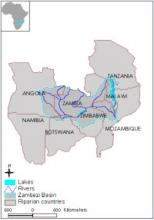Informations générale

Secretariat, P. O. Box 30233 Lusaka, Zambia
Données de base
Annual rainfall in the basin varies from 1,800 mm/year in the north to 550 mm/year or less in the south of the basin.
With a total irrigation potential of about 3.2 million ha only about 1.2 million ha are currently under irrigation.
Site Internet
Couverture géographique
The Zambezi water course system refers to both surface and groundwater resources of the Zambezi river. It is the largest shared watercourse system in Southern Africa.
| Pays | Superficie |
|---|---|
|
Angola
|
252600km²
|
|
Botswana
|
21900km²
|
|
Malawi
|
112100km²
|
|
Mozambique
|
168000km²
|
|
Namibie
|
21000km²
|
|
Tanzanie
|
27999km²
|
|
Zambie
|
574000km²
|
|
Zimbabwe
|
224000km²
|
Fonction/mandat
The objective of the Commission is to promote the equitable and reasonable utilization of the water resources of the Zambezi watercourse, and their efficient management and sustainable development. The ZAMCOM advises the member states on the planning, management, utilization, development, protection, and conservation of the Zambezi. The Commission also advises on measures necessary to avoid disputes between the member states and assists in the resolution of conflicts. ZAMCOM collects, evaluates, and disseminates information and data relevant to the implementation of the agreements and fosters greater awareness for the efficient and sustainable management and development of the Zambezi among the population. Furthermore, ZAMCOM aims at promoting, supporting, coordinating and harmonizing the management and development of the water resources and the national water policies.
Fonctionnement
ZAMCOM consists of the council of ministers, a Technical Committee and a Secretariat.
The Zambesi Watercourse Commission, ZAMCOM, consists of the Council of Ministers, the Technical Committee, and the Secretariat. The Council is composed of one delegate from each member state. A Chairperson and Vice-Chairperson are elected on the basis of rotation. The Technical Committee is made up of three representatives from each member state and are primarily responsible for implementing the Council’s decisions and developing the River Basin Management Strategy. The Secretariat is headed by an Executive Secretary and is responsible for the technical and administrative support of the Council.
ZAMCOM is currently working on the development of an Integrated Water Management Plan for the Zambezi River System, a project already initiated in the 1990s as part of the Action Plan for the Environmentally Sound Management of the Common Zambezi River System (ZACPLAN). ZAMCOM took over the responsibility from the bi-national Zambezi River Authority (ZRA).
All member states are obliged to inform ZAMCOM of any program, project or activity with regard to the Zambezi watercourse. If one of the other member states opposes planned measures or activities, they are required to start consultations and negotiations and reach a solution. The project is to be postponed during these negotiations. Furthermore, the Commission can conduct a fact-finding study to support the negotiation process.
Decisions are taken unanimously, with two thirds of the member states forming a quorum. In case of a dispute the member states are required to enter into consultations and negotiations. The Council of Ministers may give recommendations. If a dispute cannot be settled, it can be referred to the SADC Tribunal. Disputes between a member state and ZAMCOM can also be brought before the Tribunal.
All member states contribute equally to the budget of the Commission. Further details are to be elaborated by the Council.
All member states contribute equally to the budget of the Commission. Further details are to be elaborated by the Council.
Plans to establish a river basin organization have existed since the 1980s, but no serious progress was made towards institutionalization of a basin-wide cooperation. In 1987, the governments of the Riparian Countries adopted the Action Plan for the Environmentally Sound Management of the Common Zambezi River System (ZACPLAN). Angola, Namibia, and Malawi joined these efforts in 1990. ZACPLAN consists of 19 projects, the so-called Zambezi Action Projects (ZACPRO). In 2002 the SADC Secretariat headed several rounds of negotiations until finally in July 2004 the Agreement establishing the Zambezi Watercourse Commission (ZAMCOM) was signed.
Bases légales
| Date | Nom du traité | Signataires | Bassin |
|---|---|---|---|
|
1891-06-11
|
Spheres of Influence Treaty
|
Great Britain
|
Bassin du Limpopo
|
|
1953-01-21
|
Shire Valley Participation Tretay
|
Great Britain
Portugal
|
Bassin du Zambèze
|
|
1954-11-18
|
Kwando River Agreement
|
Great Britain
Portugal
|
- |
|
1963-11-25
|
Power Corp Agreement
|
Northern Rhodesia
Southern Rhodesia
|
Bassin du Zambèze
|
|
1967-04-01
|
Hydropower Agreement
|
Portugal
South Africa
|
Bassin du Zambèze
|
|
1984-05-02
|
Cahora Bassa Project
|
Mozambique
Portugal
South Africa
|
Bassin du Zambèze
|
|
1987-05-28
|
Action Plan
|
Botswana
Mozambique
Tanzania
Zambia
Zimbabwe
|
Bassin du Zambèze
|
|
1987-07-28
|
Zambezi River Utilization Agreement
|
Zambia
Zimbabwe
|
Bassin du Zambèze
|
|
2004-07-13
|
ZAMCOM Agreement
|
Angola
Botswana
Malawi
Mozambique
Namibia
Tanzania
Zambia
Zimbabwe
|
Bassin du Zambèze
|
Challenges
Very large underdeveloped basin, rampant poverty, hydropower/irrigation potential partially tapped, environmental impact assessment required, Zambia (41% of basin area) not a member of ZAMCOM, low stakeholder involvement and limited financial resources, lack of basinwide organization for water resources management, inadequate political dialogue on IWRM, lack of common vision, inadequate funding and lack of cooperation mechanism.
 AWIS/Sadieau
AWIS/Sadieau